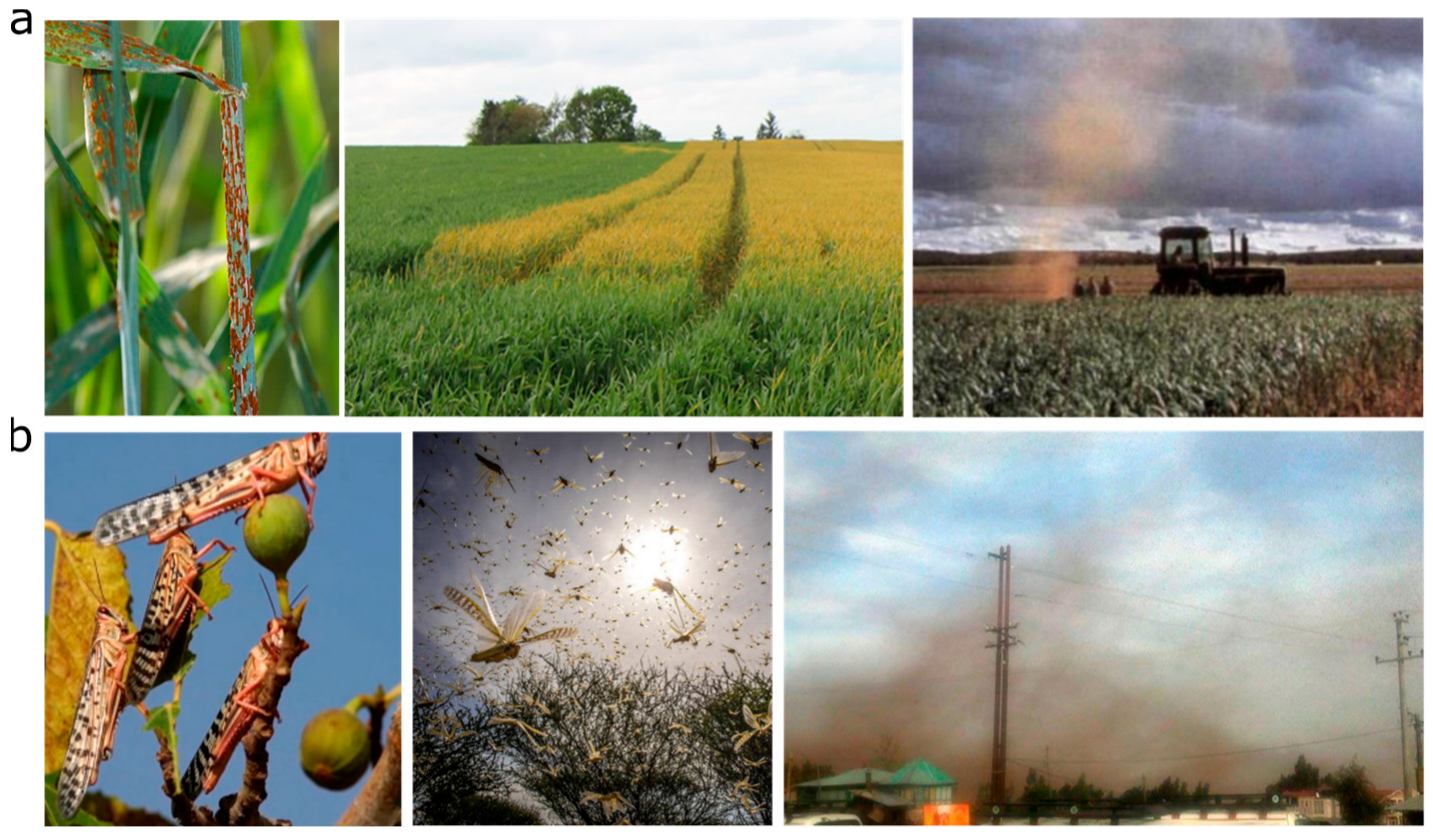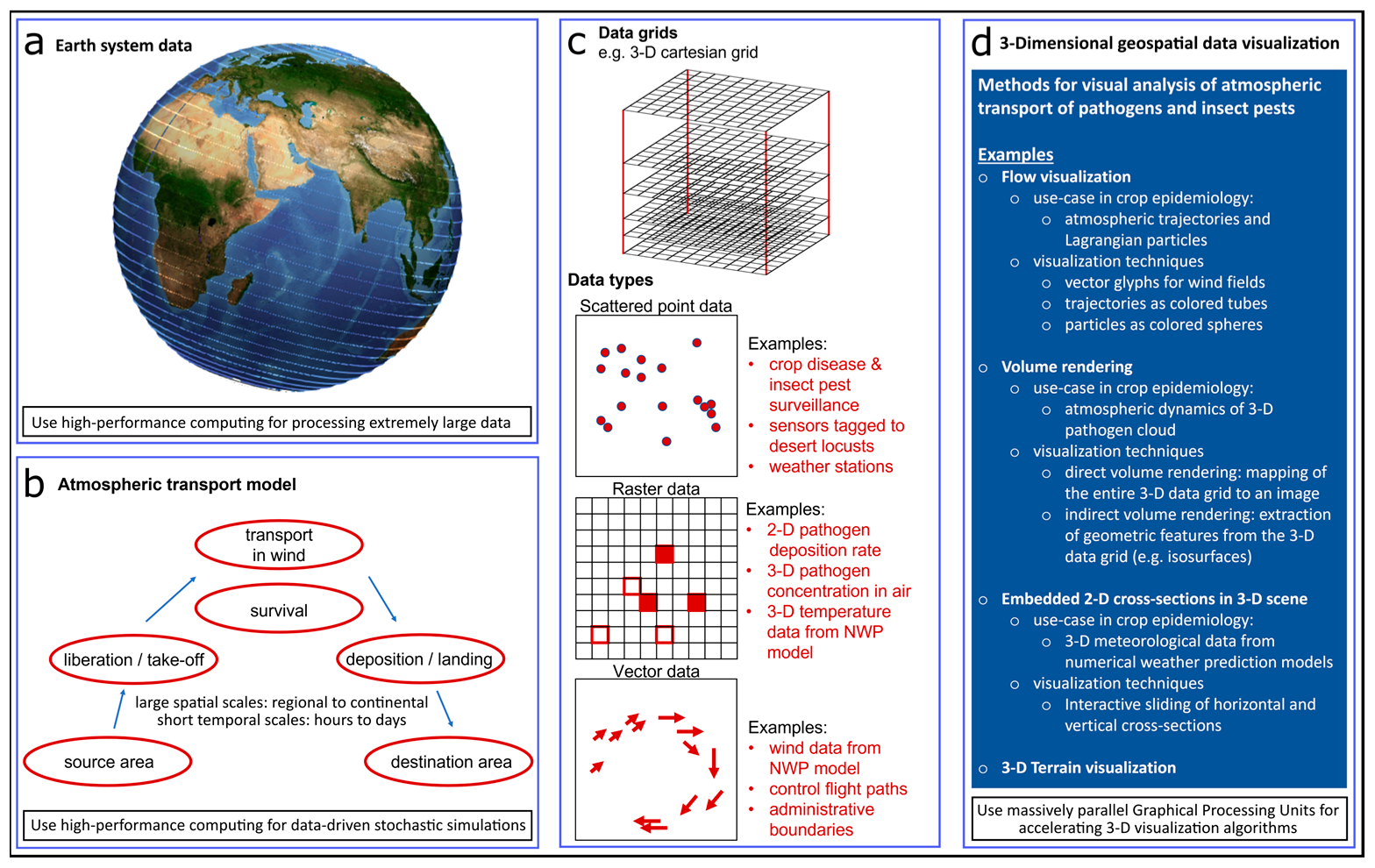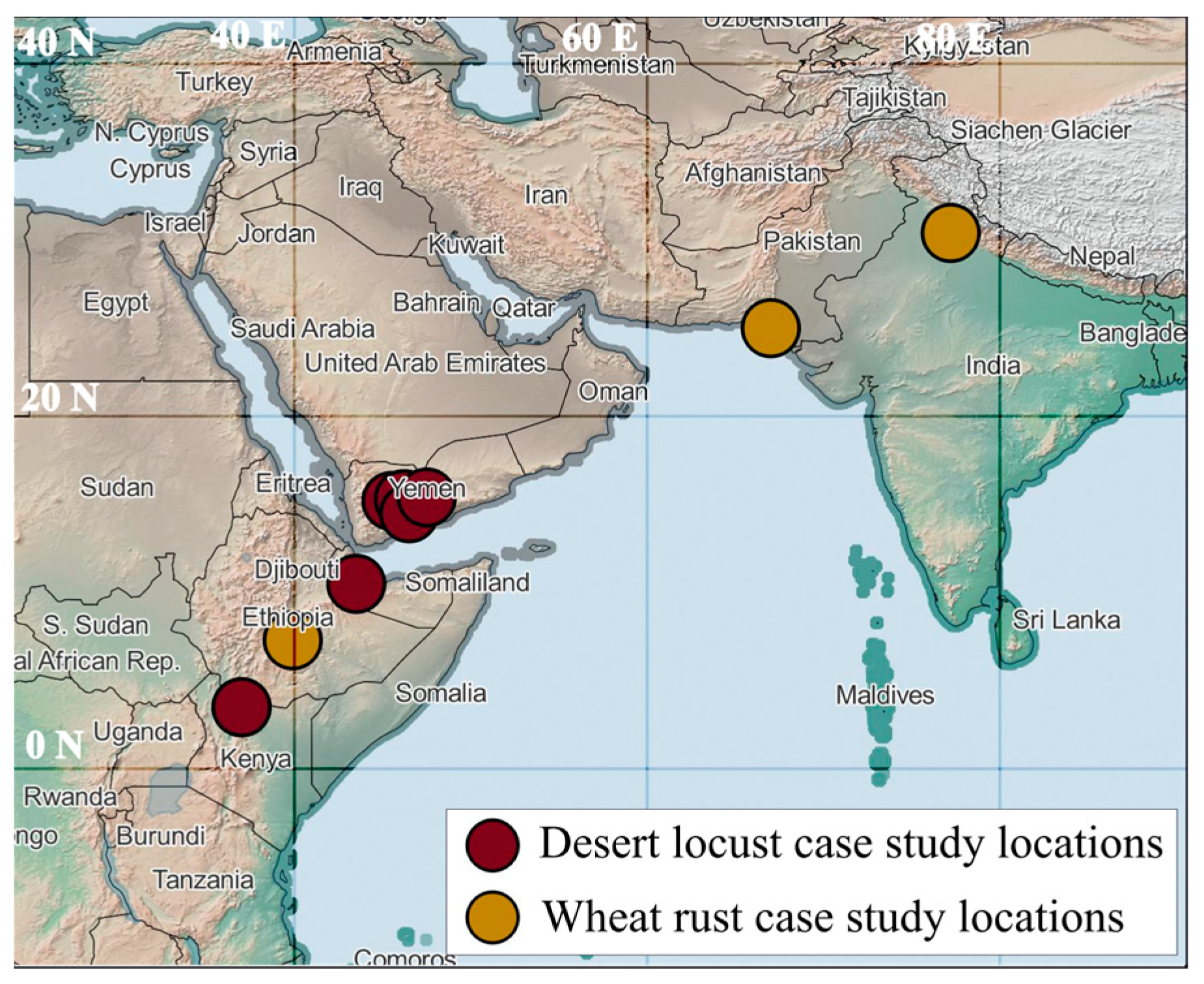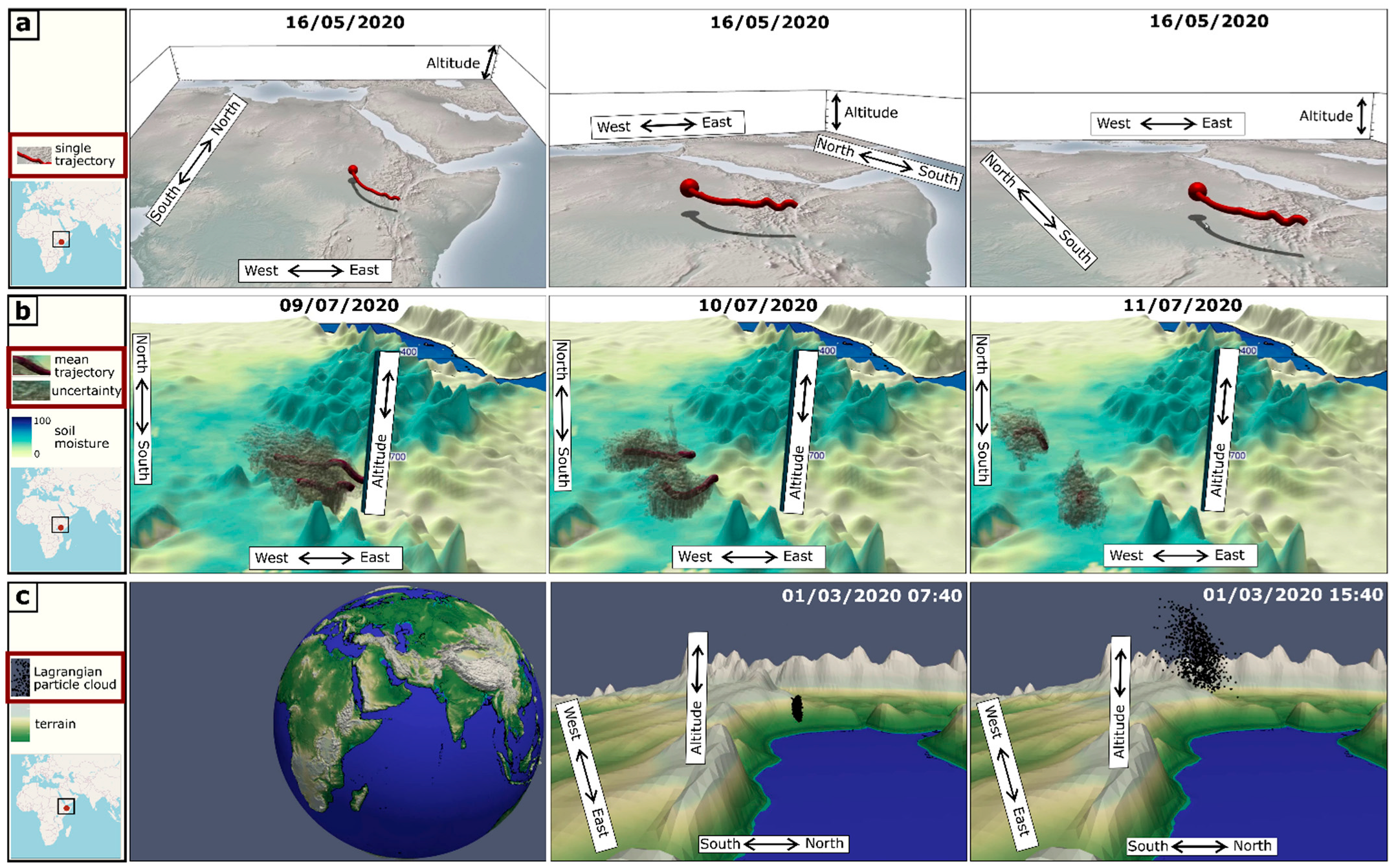Three-Dimensional Visualization of Long-Range Atmospheric Transport of Crop Pathogens and Insect Pests
Abstract
:1. Introduction
2. Materials and Methods
2.1. Study Region
2.2. Crop Disease and Insect Pest Surveillance Data
2.3. Meteorological Data
2.4. Atmospheric Transport Simulations
2.5. Three-Dimensional Visual Data Analysis
2.6. Computing Hardware
2.7. Prototype for Automated 3D Visualization of Short-Term Forecasts of Desert Locust Swarm Flight
2.8. Evaluation in Context of Operational Crop Disease and Pest Management Systems
3. Results
3.1. Case 1: Wheat Rusts
3.1.1. Time-Lapse of Three-Dimensional Dynamics of Extremely Long-Distance Atmospheric Transport Events
3.1.2. Interactive 3D Visual Analysis of Extremely Long-Range Atmospheric Pathogen Transport
3.2. Case 2: Desert Locusts
3.2.1. Three-Dimensional Visualization of Long-Range Desert Locust Swarm Flight
3.2.2. Automated Three-Dimensional Visualization of Short-Term Desert Locust Swarm Flight Forecasts
4. Discussion
5. Conclusions
Supplementary Materials
Author Contributions
Funding
Institutional Review Board Statement
Informed Consent Statement
Data Availability Statement
Acknowledgments
Conflicts of Interest
References
- Aylor, D.E. Aerial Dispersal of Pollen and Spores; American Phytopathological Society: St. Paul, MN, USA, 2017. [Google Scholar]
- Meyer, M.; Cox, J.A.; Hitchings, M.D.T.; Burgin, L.; Hort, M.C.; Hodson, D.P.; Gilligan, C.A. Quantifying airborne dispersal routes of pathogens over continents to safeguard global wheat supply. Nat. Plants 2017, 3, 780–786. [Google Scholar] [CrossRef] [PubMed]
- Brown, J.K.M.; Hovmøller, M.S. Aerial dispersal of pathogens on the global and continental scales and its impact on plant disease. Science 2002, 297, 537–541. [Google Scholar] [CrossRef] [PubMed]
- Chapman, J.W.; Reynolds, D.R.; Wilson, K. Long-range seasonal migration in insects: Mechanisms, evolutionary drivers and ecological consequences. Ecol. Lett. 2015, 18, 287–302. [Google Scholar] [CrossRef] [PubMed]
- Isard, S.A.; Russo, J.M.; Ariatti, A. The integrated aerobiology modeling system applied to the spread of soybean rust into the Ohio River valley during September 2006. Aerobiologia 2007, 23, 271–282. [Google Scholar] [CrossRef]
- Roelfs, A.P.; Singh, R.P.; Saari, E.E. Rust Diseases of Wheat: Concepts and Methods of Disease Management; CIMMYT International Maize and Wheat Improvement Center: Texcoco, Mexico, 1992. [Google Scholar]
- Symmons, P.M.; Cressman, K. Desert Locust Guidelines Biology and Behavior; Food and Agriculture Organization of the United Nations: Rome, Italy, 2001. [Google Scholar]
- Gregory, P.H. The dispersion of air-borne spores. Trans. Br. Mycol. Soc. 1945, 28, 26–72. [Google Scholar] [CrossRef]
- Chapman, J.W.; Nesbit, R.L.; Burgin, L.E.; Reynolds, D.R.; Smith, A.D.; Middleton, D.R.; Hill, J.K. Flight orientation behaviors promote optimal migration trajectories in high-flying insects. Science 2010, 327, 682–685. [Google Scholar] [CrossRef]
- Schmale, D.G.; Ross, S.D.; Fetters, T.L.; Tallapragada, P.; Wood-Jones, A.K.; Dingus, B. Isolates of Fusarium graminearum collected 40–320 meters above ground level cause fusarium head blight in wheat and produce trichothecene mycotoxins. Aerobiologia 2012, 28, 1–11. [Google Scholar] [CrossRef]
- Viljanen-Rollinson, S.L.H.; Parr, E.L.; Marroni, M.V. Monitoring long distance spore dispersal by wind—A review. N. Z. Plant Prot. 2007, 60, 291296. [Google Scholar] [CrossRef]
- Ahmadi, P.; Mansor, S.; Farjad, B.; Ghaderpour, E. Unmanned Aerial Vehicle (UAV)-Based Remote Sensing for Early-Stage Detection of Ganoderma. Remote Sens. 2022, 14, 1239. [Google Scholar] [CrossRef]
- Zhang, X.; Bian, F.; Wang, Y.; Hu, L.; Yang, N.; Mao, H. A Method for Capture and Detection of Crop Airborne Disease Spores Based on Microfluidic Chips and Micro Raman Spectroscopy. Foods 2022, 11, 3462. [Google Scholar] [CrossRef]
- Aylor, D.E. The role of intermittent wind in the dispersal of fungal pathogens. Annu. Rev. Phytopathol. 1990, 28, 73–92. [Google Scholar] [CrossRef]
- Cohen, M.; Zinn, S.; Cressman, K.; Newcomb, L.; Matlock, G.; Stein, A. Locust Forecasting with the NOAA Hysplit model. In Proceedings of the American Meteorological Society, 101st Annual Meeting, Virtual, 10–15 January 2020. [Google Scholar]
- Isard, S.A.; Gage, S.H.; Comtois, P.l.; Russo, J.M. Principles of the atmospheric pathway for invasive species applied to soybean rust. BioScience 2005, 55, 851–861. [Google Scholar] [CrossRef]
- Olivera-Firpo, P.D.; Newcomb, M.; Szabo, L.J.; Rouse, M.N.; Johnson, J.L.; Gale, S.W.; Luster, D.; Hodson, D.P.; Cox, J.A.; Burgin, L.E.; et al. Phenotypic and genotypic characterization of race TKTTF of Puccinia graminis f. sp. tritici that caused a wheat stem rust epidemic in southern Ethiopia in 2013/14. Phytopathology 2015, 105, 917–928. [Google Scholar] [CrossRef]
- Meyer, M.; Burgin, L.; Hort, M.C.; Hodson, D.P.; Gilligan, C.A. Large scale atmospheric dispersal simulations identify likely airborne incursion routes of wheat stem rust into Ethiopia. Phytopathology 2017, 107, 1175–1186. [Google Scholar] [CrossRef]
- Prank, M.; Kenaley, S.C.; Bergstrom, G.C.; Acevedo, M.; Mahowald, N.M. Climate change impacts the spread potential of wheat stem rust, a significant crop disease. Environ. Res. Lett. 2019, 14, 124053. [Google Scholar] [CrossRef]
- Visser, B.; Meyer, M.; Park, R.F.; Gilligan, C.A.; Burgin, L.E.; Hort, M.C.; Hodson, D.P.; Pretorius, Z.A. Microsatellite analysis and urediniospore dispersal simulations support the movement of Puccinia graminis f. sp. tritici from southern Africa to Australia. Phytopathology 2019, 109, 133–144. [Google Scholar] [CrossRef]
- Wang, Y.P.; Wu, M.F.; Lin, P.J.; Wang, Y.; Chen, A.D.; Jiang, Y.Y.; Zhai, B.P.; Chapman, J.W.; Hu, G. Plagues of Desert Locusts: Very Low Invasion Risk to China. Insects 2020, 11, 628. [Google Scholar] [CrossRef]
- Cunniffe, N.J.; Koskella, B.E.; Metcalf, C.J.; Parnell, S.; Gottwald, T.R.; Gilligan, C.A. Thirteen challenges in modelling plant diseases. Epidemics 2015, 10, 6–10. [Google Scholar] [CrossRef]
- Allen-Sader, C.; Thurston, W.; Meyer, M.; Nure, E.; Bacha, N.; Alemayehu, Y.; Stutt, R.O.J.H.; Safka, D.; Craig, A.P.; Derso, E.; et al. An early warning system to predict and mitigate wheat rust diseases in Ethiopia. Environ. Res. Lett. 2019, 14, 115004. [Google Scholar] [CrossRef]
- Isard, S.A.; Russo, J.M.; Magarey, R.D.; Golod, J.; VanKirk, J.R. Integrated pest information platform for extension and education (iPiPE): Progress through sharing. J. Integr. Pest Manag. 2015, 6, 15. [Google Scholar] [CrossRef]
- Cressman, K. Current methods of desert locust forecasting at FAO. EPPO Bull. 1996, 26, 577–585. [Google Scholar] [CrossRef]
- Cressman, K. Desert Locust Guidelines Information and Forecasting; Food and Agriculture Organization of the United Nations: Rome, Italy, 2001. [Google Scholar]
- Cressman, K. The use of new technologies in desert locust early warning. Outlooks Pest Manag. 2008, 19, 55–59. [Google Scholar] [CrossRef]
- McIntosh, R.A.; Wellings, C.R.; Park, R.F. Wheat Rusts: An Atlas of Resistance Genes; CSIRO Publications: Melbourne, Australia, 1995. [Google Scholar]
- Orf, L.; Wilhelmson, R.; Lee, B.; Finley, C.; Houston, A. Evolution of a Long-Track Violent Tornado within a Simulated Supercell. Bull. Am. Meteorol. Soc. 2017, 98, 45–68. [Google Scholar] [CrossRef]
- Rautenhaus, M.; Böttinger, M.; Siemen, S.; Hoffman, R.; Kirby, R.M.; Mirzargar, M.; Röber, N.; Westermann, R. Visualization in Meteorology—A Survey of Techniques and Tools for Data Analysis Tasks. IEEE Trans. Vis. Comput. Graph. 2018, 24, 3268–3296. [Google Scholar] [CrossRef]
- Roeber, N.; Boettinger, M. Visualization of Climate Science Simulation Data. IEEE Comput. Graph. Appl. 2021, 41, 42–48. [Google Scholar] [CrossRef]
- Wright, H. Introduction to Scientific Visualization; Springer: London, UK, 2007. [Google Scholar]
- Ayachit, U. The ParaView Guide: A Parallel Visualization Application; Kitware: New York, NY, USA, 2015. [Google Scholar]
- Li, S.; Jaroszynski, S.; Pearse, S.; Orf, L.; Clyne, J. VAPOR: A Visualization Package Tailored to Analyze Simulation Data in Earth System Science. Atmosphere 2019, 10, 488. [Google Scholar] [CrossRef]
- Yu, L. MeteoExplorer: Visual data analysis software for atmospheric and geoscientists. Meteorol. Appl. 2020, 27, e1916. [Google Scholar] [CrossRef]
- Rautenhaus, M.; Kern, M.; Schäfler, A.; Westermann, R. Three-dimensional visualization of ensemble weather forecasts—Part 1: The visualization tool Met.3D (version 1.0). Geosci. Model Dev. 2015, 8, 2329–2353. [Google Scholar] [CrossRef]
- Rautenhaus, M.; Grams, C.M.; Schäfler, A.; Westermann, R. Three-dimensional visualization of ensemble weather forecasts—Part 2: Forecasting warm conveyor belt situations for aircraft-based field campaigns. Geosci. Model Dev. 2015, 8, 2355–2377. [Google Scholar] [CrossRef]
- Cressman, K. Desert Locust, Biological and Environmental Hazards, Risks, and Disasters; Shroder, J.F., Sivanpillai, R., Eds.; Elsevier: Amsterdam, The Netherlands, 2016; pp. 87–105. [Google Scholar]
- CIMMYT—RustTracker. A Global Wheat Rust Monitoring System. 2019. Available online: http://rusttracker.cimmyt.org/ (accessed on 20 May 2023).
- FAO Desert Locust Data. Available online: https://www.fao.org/locusts/en/ (accessed on 20 May 2023).
- Walters, D.; Baran, A.J.; Boutle, I.; Brooks, M.; Earnshaw, P.; Edwards, J.; Furtado, K.; Hill, P.; Lock, A.; Manners, J.; et al. The Met office unified model global atmosphere 7.0/7.1 and JULES global land 7.0 configurations. Geosci. Model Dev. 2019, 12, 1909–1963. [Google Scholar] [CrossRef]
- Jones, A.; Thomson, D.; Hort, M.; Devenish, B. The UK Met office’s next generation atmospheric dispersion model NAMEIII. In Air Pollution Modelling and Its Application; Borrego, C., Norman, L.A., Eds.; Springer: Berlin/Heidelberg, Germany, 2007; pp. 580–589. [Google Scholar] [CrossRef]
- Stein, A.F.; Draxler, R.R.; Rolph, G.D.; Stunder, B.J.B.; Cohen, M.D.; Ngan, F. NOAA’s HYSPLIT atmospheric transport and dispersion modeling system. Bull. Am. Meteorol. Soc. 2015, 96, 2059–2077. [Google Scholar] [CrossRef]
- Met.3D—Code Repository. Available online: https://gitlab.com/wxmetvis/met.3d (accessed on 20 May 2023).
- Meyer, M.; Polkova, I.; Modali, K.R.; Schaffer, L.; Baehr, J.; Olbrich, S.; Rautenhaus, M. Interactive 3-D visual analysis of ERA5 data: Improving diagnostic indices for marine cold air outbreaks and polar lows. Weather Clim. Dyn. 2021, 2, 867–891. [Google Scholar] [CrossRef]
- Youssefi, F.; Zoej, M.J.V.; Hanafi-Bojd, A.A.; Dariane, A.B.; Khaki, M.; Safdarinezhad, A.; Ghaderpour, E. Temporal Monitoring and Predicting of the Abundance of Malaria Vectors Using Time Series Analysis of Remote Sensing Data through Google Earth Engine. Sensors 2022, 22, 1942. [Google Scholar] [CrossRef]
- Zhao, H.; Yang, C.; Guo, W.; Zhang, L.; Zhang, D. Automatic Estimation of Crop Disease Severity Levels Based on Vegetation Index Normalization. Remote Sens. 2020, 12, 1930. [Google Scholar] [CrossRef]







| Advantages | Disadvantages |
|---|---|
| Three-dimensional visualization enhanced our understanding and assessment of risk in areas with complex terrain. For example, it provided useful novel insights into complex transport patterns in the East African Rift Valley (Section 3.2.1; Movie S7) and around the Himalayas (Section 3.1; Movies S2–S3). | Producing 3D visualizations is resource demanding (high computational costs; time-consuming manual configuration of 3D scene). |
| Three-dimensional visualization enhanced our understanding and assessment of risk in cases with complex anisotropic wind flow patterns. For example, it helped to identify an unusual atmospheric flow regime that increased the risk for desert locust flight from Yemen over the Gulf of Aden into the East African continent. (Section 3.2.2). | Whilst it became evident that 3D visualization has the potential to provide added value and novel insights, in many cases, it did not add substantive value to standard 2D maps. |
| Interactive 3D visualization enables detailed exploratory analyses of specific cases of extremely long-distance transport events by providing insights into 3D structure and dynamics of simulation particle clouds and simulation particle density fields (Movies S4 and S5). It can help to improve understanding of atmospheric transport model behavior and model calibration. For example, it has motivated the development of a new temperature-dependent flight altitude scheme to improve forecasting of DL swarm movements (Section 3.2.1). | Spatial perception is a key challenge in complex 3D scenes and often a sequence of 2D maps (e.g., along different altitudes) provides a clearer visualization that is easier to interpret and relate to observational data. Spatial perception is especially challenging when visualizing 3D spatiotemporal dynamics of scalar particle density fields (e.g., Movies S9–S11). |
| Combined interactive visualization of transport simulation data and meteorological data in one 3D scene helps analyze complex interactions between meteorology and pathogen/pest transport quantities and as such is useful for studying mechanisms driving long-distance atmospheric transport events (e.g., Movies S2–S5). | The 3D visualizations are only as good as the 3D simulation data, which induces a notable uncertainty due to limitations in availability of high-quality multi-dimensional empirical data for calibration and validation of simulations. |
| Three-dimensional visualizations provide valuable material for communication, outreach, and raising awareness of risks to agricultural production. For example, 3D visuals can illustrate the various complex model components involved in atmospheric transport simulations and facilitate cross-disciplinary dialogue between modellers and practitioners advising on disease risk and control. | The level of detail in 3D visualizations (e.g., 3D spatiotemporal dynamics of simulated DL swarm flight) goes far beyond the level of detail that is currently available in most observational data. This makes rigorous quantitative validation of representativeness of 3D visuals extremely difficult. |
| Three-dimensional visualizations provide new perspectives compared with standard 2D maps, which may facilitate the formulation of new hypotheses. | The level of detail in 3D visualizations in some cases goes beyond the level of detail required for making informed decisions about the scale of surveillance and control. As such, 3D visualization is not relevant for practical decisions about surveillance and control measures in some cases. |
Disclaimer/Publisher’s Note: The statements, opinions and data contained in all publications are solely those of the individual author(s) and contributor(s) and not of MDPI and/or the editor(s). MDPI and/or the editor(s) disclaim responsibility for any injury to people or property resulting from any ideas, methods, instructions or products referred to in the content. |
© 2023 by the authors. Licensee MDPI, Basel, Switzerland. This article is an open access article distributed under the terms and conditions of the Creative Commons Attribution (CC BY) license (https://creativecommons.org/licenses/by/4.0/).
Share and Cite
Meyer, M.; Thurston, W.; Smith, J.W.; Schumacher, A.; Millington, S.C.; Hodson, D.P.; Cressman, K.; Gilligan, C.A. Three-Dimensional Visualization of Long-Range Atmospheric Transport of Crop Pathogens and Insect Pests. Atmosphere 2023, 14, 910. https://doi.org/10.3390/atmos14060910
Meyer M, Thurston W, Smith JW, Schumacher A, Millington SC, Hodson DP, Cressman K, Gilligan CA. Three-Dimensional Visualization of Long-Range Atmospheric Transport of Crop Pathogens and Insect Pests. Atmosphere. 2023; 14(6):910. https://doi.org/10.3390/atmos14060910
Chicago/Turabian StyleMeyer, Marcel, William Thurston, Jacob W. Smith, Alan Schumacher, Sarah C. Millington, David P. Hodson, Keith Cressman, and Christopher A. Gilligan. 2023. "Three-Dimensional Visualization of Long-Range Atmospheric Transport of Crop Pathogens and Insect Pests" Atmosphere 14, no. 6: 910. https://doi.org/10.3390/atmos14060910







